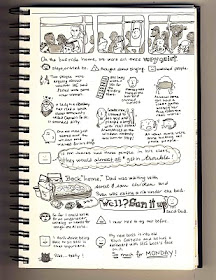 Hi, Gang!
Hi, Gang!A quick reminder about TeachingAuthors’ latest book giveaway for Karen Romano Young’s intriguing graphic novel about a girl who keeps a doodles-and-writing journal, Doodlebug: A Novel in Doodles. Entry deadline is 11 pm (CST) Wednesday, August 4, 2010. For details, read this post.
More about keeping a journal in a minute.
OUT AND ABOUT
But first...I’m at the SCBWI’s 39th Annual International Summer Conference in my home state of California! (TeachingAuthors’ very own Esther Hershenhorn is featured on the first web page about the conference with her timeless article, Confessions and Secrets of a Veteran SCBWI Conference-Goer!) 2010 is SCBWI's biggest year ever, with over a thousand attendees!
 |
| The photo is from SCBWI's website...it's actually from the annual Winter Conference...but you get the idea: big, enthusiastic crowd! |
Critiquing means you have lots of work before the conference. It takes me at least an hour--sometimes two--to write the critique I give each of the ten or so writers I'm assigned.
My favorite part is having a full half hour to talk with each person about their work. As we’ve just read in the last few posts on critique groups, you walk a fine line…you want to encourage…and you also want to help make that manuscript the best it can possibly be. You do NOT want to squash the person’s fragile ego like a bug on the sidewalk. That’s easy to do!
I do my best to follow Jeanne Marie Grunwell Ford's suggestions: "PQP -- Praise, Question, Polish. Start with praise. Always. There's something good you can find. Somewhere. Always. Usually you can find a way to end on an encouraging note, as well. In between, be constructive, be specific, and offer suggestions."
 |
| Be gentle! That's the writer's heart... |
That's the journal I call my news journal, and satisfies the journalist in me. But something was missing. The artistic flying-squirrel-crazed-angel part of me didn’t have a platform. Where were my poems, my colors, my thoughts that didn’t march in a logical procession?
When I took the Poem-A-Day Challenge in April of 2010, I wrote and posted a poem each day for the month of April.
That challenge forced me to put poetry among the top three priorities in my life (The other two? Health and family). A writer is SUPPOSED to make writing a top priority …but this? This was like pouring jet fuel into my poetry paper airplane!
So even though the official Poem-A-Day Challenge ended on April 30th, I’ve kept a daily poetry journal, in which I write one poem a day, ever since. I email each poem to one of my best friends, author Bruce Balan, who is sailing around the world in his trimaran named Migration (named for his picture book, The Cherry Migration.) Right now he’s in Tonga. How cool is that?
 |
“Write a one-minute journal each day. Take only one minute to record the thing you most want to remember about that day. It can be weighty—that your friend passed the bar exam, for example. But it could be that one moment—seeing the long slant of the sun on a skateboarder as she skated past.”
Go ahead. Attack a fresh page--with words and/or doodles--for one minute. You’ll be glad you did.
 | |
| And of course, write with joy. |












